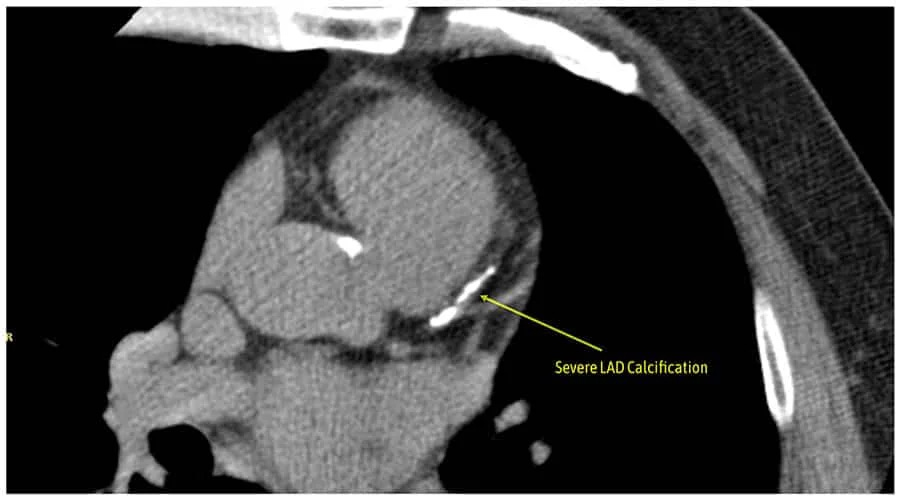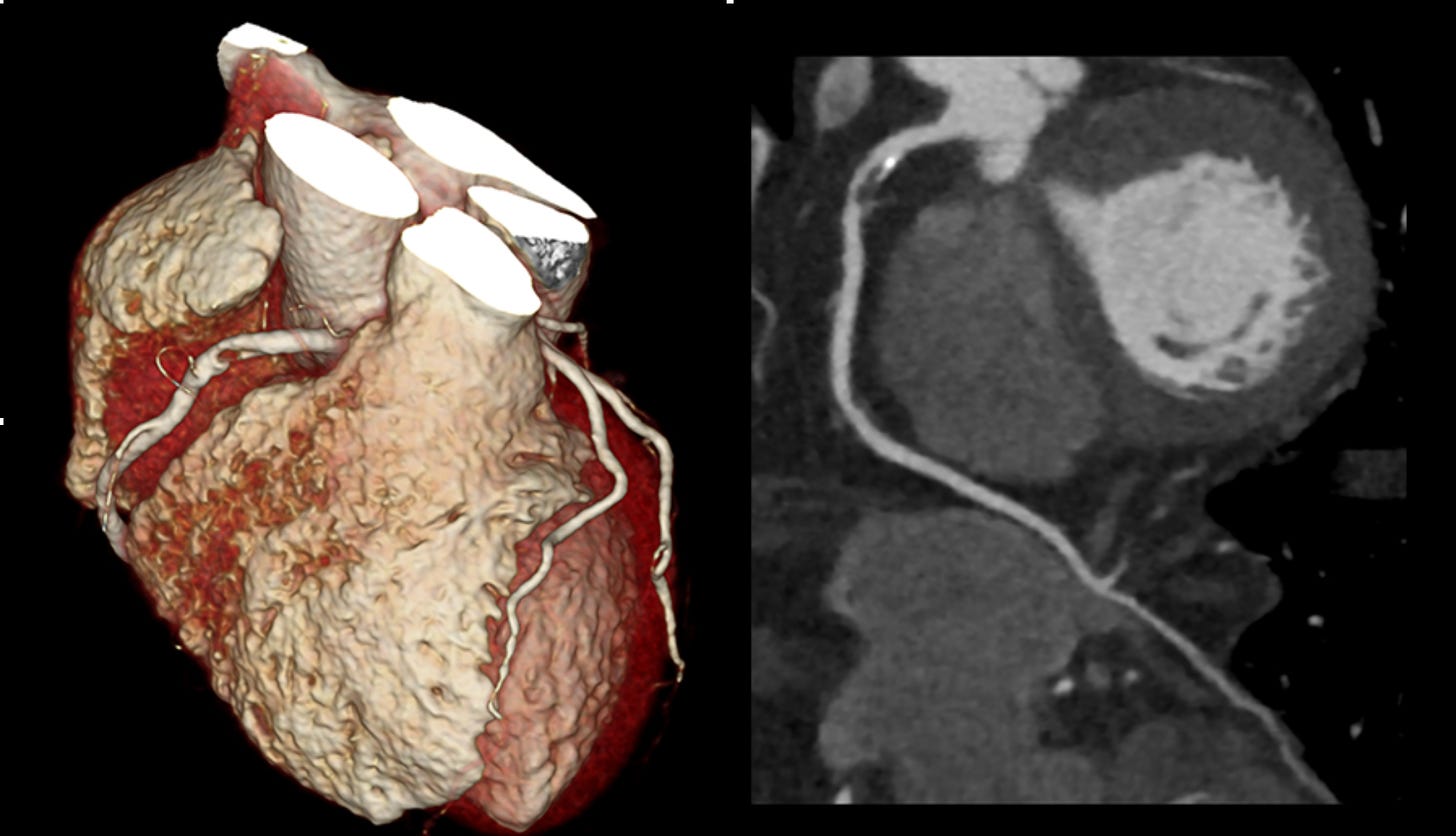The Advantages Of A CT Coronary Angiogram

CT coronary angiography, in addition to a CT CAC, is arguably the best test for estimating whether someone has evidence of coronary artery disease and what that means for their near-term risk of a heart attack.
This article is part 2 of a series on cardiac CT. Part one explored the utility and benefits of CT Calcium Scoring.
If you have not yet read it, I suggest doing so before reading the remainder of this article. I've included the article here.
CT coronary angiography (CTCA) is a CT scan of the heart that is more anatomically detailed than a CT Calcium Score and requires contrast.
Historically, the radiation required to perform CTCA scans was relatively high, but with the advent of newer scanning technologies, that dose has been significantly reduced1.
A CT CAC scan can only identify if there is calcified atherosclerosis, where it is and to what extent.
A CTCA provides much more anatomical detail and can identify advanced plaque often missed by CT Coronary Artery Calcium Score scans alone.
CT Coronary Artery Calcium Score Scan

CT Coronary Angiogram

As you can see from the above images, the CTCA provides far more anatomical detail.
Although a more visually impressive scan, are there real benefits to having a CTCA scan over a CT CAC scan?
I would say yes.
Chest Pain Symptoms
There is no role for CT Calcium Scoring in the setting of someone with chest pain symptoms suspected to be from a narrowed coronary artery.
CTCA is now seen as a first-line test to evaluate such patients.
For very good reason.
First off, CTCA is a noninvasive test, and many patients with chest pain would previously have needed invasive angiography with all the risks it entails, including heart attack, stroke and death (albeit very rare).
The use of CTCA is often the only test that is required, therefore, avoiding further invasive testing.
This approach also reduces death from heart disease and heart attacks by 41% compared to conventional approaches such as exercise stress testing2.
To be fair, it seems highly implausible that a diagnostic test would impact event rates to such a degree, but I suspect much of the effect was down to more intensive medical therapies being prescribed and changes in patient behaviour.
Regardless, if you present with chest pain and get a stress test instead of a CTCA, you are arguably getting an inferior test.
Risk Stratification
CT CAC scans have typically been the mainstay of imaging for risk assessment, and CTCA has been limited to those with suspected obstructive coronary artery disease.
But CTCA scans are now increasingly used to identify patients with advanced coronary artery disease on the basis of risk stratification.
This is now part of the European Society Guideline indications and not simply an off-label use3.
What does a CTCA see that a CAC Scan doesn’t?
A lot.
And it matters.
A CT CAC scan of 0 indicates no significant amount of calcified atherosclerosis.
It does not imply that there is NO advanced atherosclerosis.
This is clearly stated on almost every CT CAC report but is frequently not appreciated.
There are 3 types of coronary atherosclerosis visible on CTCA:
-
Calcified Plaque - Easily Identified on both CT CAC & CTCA scans.
-
Mixed Plaque - A combination of both calcified and NON-calcified plaque. This is also visible on both CT CAC & CTCA scans because it contains elements of calcified plaque.
-
Non-Calcified Plaque - Plaque that contains NO calcification and is therefore not visible on a CT CAC scan and is ONLY visible on a CTCA.
Non-calcified plaque is often referred to as ‘soft’ or ‘vulnerable’ plaque.
While this is not an entirely accurate description, some features of non-calcified plaque suggest a higher risk of rupture in the future.
How Often Does A CT CAC Scan Miss Plaque?
More often than you would think!
In patients with a CAC = 0:
-
90% have no evidence of ANY plaque
-
7% have evidence of SOME plaque
-
1.8% have evidence of plaque-causing obstruction to the artery.

This means that about 1:10 patients with a CAC of 0 have some evidence of plaque4.
They are not fantastic odds, in my view.
And why more and more often, I choose to use CTCA for evaluating for the presence of coronary atherosclerosis.

I still use CT CAC scans for risk estimation, but I am always conscious of their limitations, and I never use it in the setting of suspected obstructive coronary artery disease.
But why do a CT if risk factor modification is the priority?
As I said in the previous article on CT CAC scans, it is now my standard practice to show my patients their scan images so that they can see the plaque for themselves.
Historically, I used to describe the report and then draw a diagram, but I show patients their own scan results more and more.
Because the evidence suggests that when we do, patients end up with better blood pressure, cholesterol control and are more likely to engage in healthier behaviours.
All things that significantly decrease cardiovascular risk over the long term.
In truth, I generally perform both tests as each has its value, and the risk models are the most robust with CT CAC scoring.
Lastly, most patients want to know if they have advanced plaque—particularly those at a younger age whose parents may have had events at a very young age.
We are obliged to answer that question for them rather than just hand-waving a risk score or set of blood test results.
Downsides Of CTCA
The radiation and contrast risk of CTCA is minimal.
The real risk is the unintended consequence of proceeding to unnecessary invasive angiography.
This is where careful discussion with the patient is required, and an explanation of the most recent literature suggests no reduction in future major heart events with stenting in most obstructive coronary artery disease5. (But that’s a whole can of worms for another day).
There is also a cost difference between CT CAC and CTCA.
This difference is not significant in most centres, and the total cost for both in most European centres is less than €500.
I have heard some horror stories from the US of CTCA scans costing between $5,000 to $10,000.
Maybe a flight to Europe is the best option ;).
Main Takeaway
You cannot die from a condition you do not have.
Both CT Coronary Artery Calcium Scoring and CT Coronary Angiography are excellent ways of identifying whether or not you have any evidence of plaque.
Having no evidence of plaque on both of these tests reflects a very low risk of a heart attack in the next five to ten years.
But as always, we are not thinking five years; we are thinking 50.
And that requires a slightly different approach.
Radiation dose and image quality of CT coronary angiography in patients with high heart rate or irregular heart rhythm using a 16-cm wide detector CT scanner. Medicine (Baltimore). 2022 Sep 16;101(37):e30583.
Coronary CT Angiography and 5-Year Risk of Myocardial Infarction. N Engl J Med. 2018 Sep 6;379(10):924-933.
ESC Scientific Document Group. 2019 ESC Guidelines for the diagnosis and management of chronic coronary syndromes. Eur Heart J. 2020 Jan 14;41(3):407-477.
Pedersen ER, Hovland S, Karaji I, et al Coronary calcium score in the initial evaluation of suspected coronary artery disease Heart 2023;109:695-701.
ISCHEMIA Research Group. Initial Invasive or Conservative Strategy for Stable Coronary Disease. N Engl J Med. 2020 Apr 9;382(15):1395-1407. doi: 10.1056/NEJMoa1915922.




